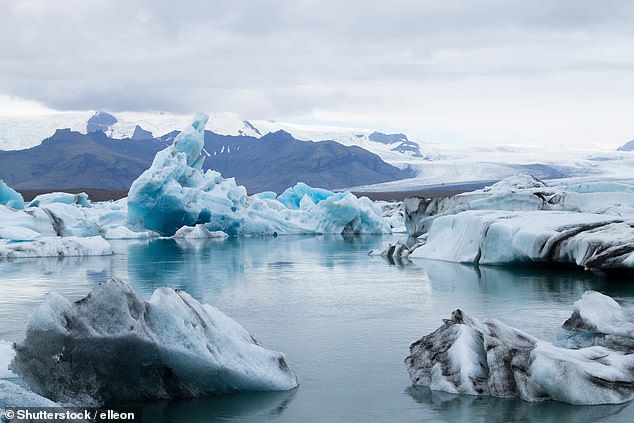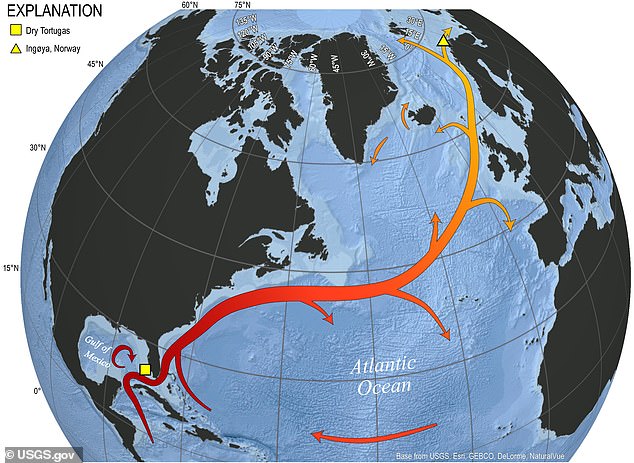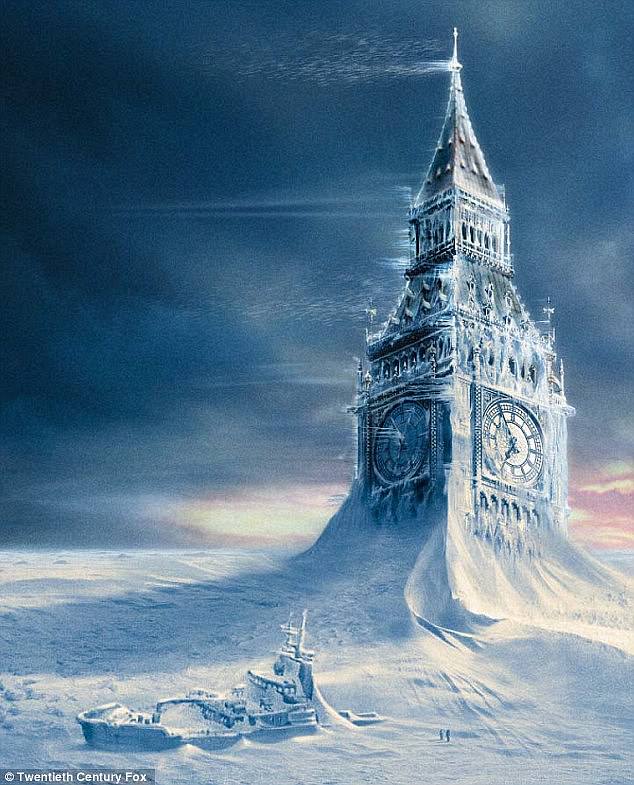Iceland has designated the potential collapse of a major Atlantic Ocean current system an existential threat and has begun planning for worst-case scenarios.
The Atlantic Meridional Overturning Circulation, or AMOC, is like a giant ocean conveyor belt that moves warm water from the tropics to the northern Atlantic, with the Gulf Stream playing a key role, acting as the main current carrying that warm water along the US East Coast to the north.
It helps keep places like northwestern Europe and the northeastern US milder in winter and influences weather patterns worldwide, including tropical rainfall.
But as warming temperatures speed the thaw of Arctic ice and cause meltwater from Greenland’s ice sheet to pour into the ocean, scientists warn the cold freshwater could disrupt the current’s flow.
A potential collapse of AMOC could trigger a modern-day ice age, with winter temperatures across Northern Europe plummeting to new cold extremes, bringing far more snow and ice.
The AMOC has collapsed in the past – notably before the last Ice Age that ended about 12,000 years ago.
‘It is a direct threat to our national resilience and security,’ Iceland Climate Minister Johann Pall Johannsson said.
‘(This) is the first time a specific climate-related phenomenon has been formally brought before the National Security Council as a potential existential threat.’

Iceland has designated the potential collapse of a major Atlantic Ocean current system an existential threat and has begun planning for worst-case scenarios
Your browser does not support iframes.

The Gulf Steam: This warm, swift current starts in the Gulf of Mexico, flows through the straits of Florida and toward North Carolina, then turns eastward as it moves toward northwestern Europe

Blanketed with snow: This satellite picture shows the extent of snow cover across Britain and Ireland on January 7, 2010. Under the modelling scenario, scenes like this could be much more common
Elevation of the issue means Iceland’s ministries will be on alert and coordinating a response, Johannsson said.
The government is assessing what further research and policies are needed, with work underway on a disaster preparedness policy.
Risks being evaluated span a range of areas, from energy and food security to infrastructure and international transportation.
An Atlantic current collapse could have consequences far beyond Northern Europe.
It could potentially destabilise longtime rainfall patterns relied upon by subsistence farmers across Africa, India and South America, according to scientists.
It could also contribute to faster warming in Antarctica, where sea ice surrounding the southernmost continent as well as ice sheets atop it are already under threat from climate change.
Scientists have warned that the world is underestimating the threat that an AMOC collapse could become inevitable within the next couple of decades as global temperatures keep climbing.
The Nordic Council of Ministers funded a ‘Nordic Tipping Week’ workshop in October with 60 experts assessing how societies might be impacted.
They are finalising recommendations from the meeting, organisers said.
‘There is tons of research on the likelihood of when exactly things are going to happen,’ said Aleksi Nummelin, a physical oceanographer at the Finnish Meteorological Institute.
‘There is much less on what is the actual societal impact.’

In the Hollywood blockbuster The Day After Tomorrow (pictured), ocean currents around the world stop as a result of global warming, triggering a new ice age on Earth. Here, Big Ben can be seen frozen over
On Monday, scientists from more than 30 universities and international organisations sounded an alarm about the accelerated thawing of Earth’s glaciers, ice sheets and other frozen spaces.
Other climate ministries and meteorological offices across Northern Europe told Reuters they are funding more research while weighing possible risks in their climate adaptation plans.
Ireland’s weather service said its scientists briefed the country’s prime minister last year and a parliamentary committee last month.
Norway’s environment ministry said it was ‘seeking to deepen our understanding of the issue through new research’ before determining whether to classify AMOC as a security risk.
Britain said it was following scientific reports that suggested an abrupt collapse was unlikely during this century, while directing more than £81million into research to understand when the Earth’s climate systems might be pushed to a point of no return.
‘The science is evolving quite rapidly and time is running out to do anything about it because the tipping point may well be quite close,’ said oceanographer and climatologist Stefan Rahmstorf from Germany’s Potsdam Institute for Climate Impact Research.
Iceland is not taking any chances, as the pace of warming speeds up and greenhouse gas emissions continue to rise.
‘Sea ice could affect marine transport; extreme weather could severely affect our capabilities to maintain any agriculture and fisheries, which are central to our economy and food systems,’ Johannsson said.
‘We cannot afford to wait for definitive, long-term research before acting.’
How does global warming affect global currents?
Scientists think melting glaciers could cause the collapse of the Atlantic Meridional Overturning Circulation or AMOC, the system of ocean currents.
Described as ‘the conveyor belt of the ocean’, the AMOC transports warm water near the ocean’s surface northwards – from the tropics up to the northern hemisphere.
When the warm water reaches the North Atlantic (Europe and the UK, and the US east coast), it releases the heat and then freezes. As this ice forms, salt is left behind in the ocean water.
Due to the large amount of salt in the water, it becomes denser, sinks, and is carried southwards – back towards the tropics – in the depths below.
Eventually, the water gets pulled back up towards the surface and warms up in a process called upwelling, completing the cycle.
Scientists think AMOC brings enough warmth to the northern hemisphere that without it, large parts of Europe could enter a deep freeze.
Prior studies have already shown that due to climate change, the AMOC is weakening (meaning the movement of heat is slowing down)
The engine of this conveyor belt is off the coast of Greenland, where, as more ice melts from climate change, more freshwater flows into the North Atlantic and slows everything down.
